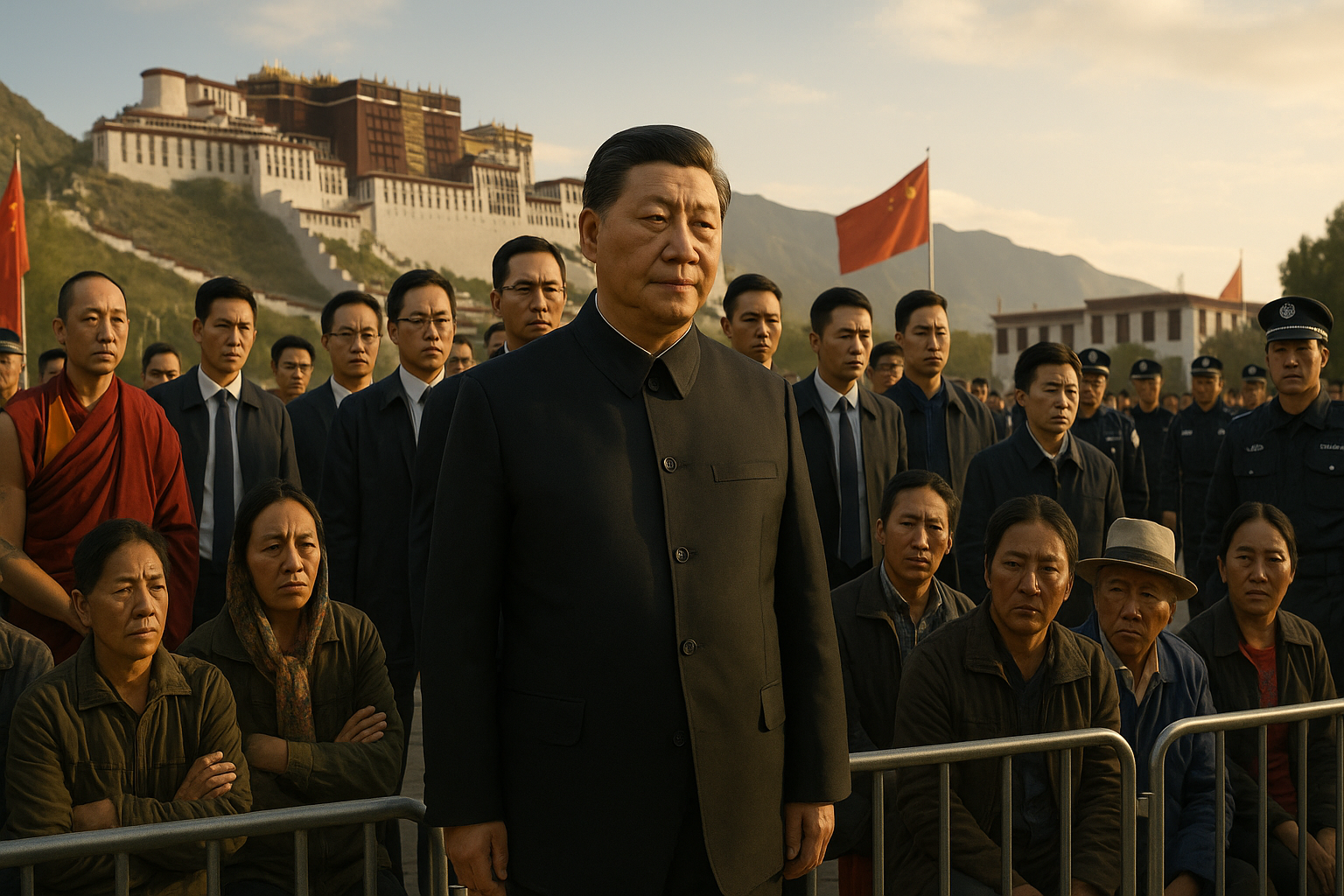Xi Jinping’s Rare Tibet Visit: Power Projection amid Political Fragility

On August 20, 2025, Chinese President Xi Jinping made a rare visit to Lhasa, Tibet, to mark the 60th anniversary of the establishment of the so-called Tibet Autonomous Region (TAR). This was only his second confirmed trip to the region since 2021. Xi’s arrival carried layers of meaning: an assertion of control over Tibet, a warning to India, and an attempt to quell growing rumours of his political weakness in Beijing.
Xi’s speech in Tibet emphasised “political stability” and “ethnic unity,” demanding that local officials adhere to the mission of sinicisation. This rhetoric echoed decades of Communist Party rule that has sought to dismantle Tibet’s culture, religion, and identity. Coming just weeks after the 14th Dalai Lama’s 90th birthday, Xi’s timing revealed Beijing’s enduring paranoia over Tibetan succession. His presence in Tibet also came immediately after Foreign Minister Wang Yi’s trip to India, signalling to New Delhi that Tibet remains central to China’s regional leverage.
The Chinese Communist Party (CCP) forcibly created the TAR in 1965, six years after the Dalai Lama fled following an unsuccessful uprising. Since then, Tibetans have been subjected to an unrelenting campaign of repression: mass killings, re-education camps, surveillance, destruction of monasteries, and systematic suppression of Tibetan Buddhism. Xi’s latest call to “guide Tibetan Buddhism to adapt to socialist society” and impose Mandarin through the “national common language” is simply a continuation of this decades-long campaign of cultural erasure.
Xi also championed the controversial US$ 167 billion hydropower project on the Yarlung Tsangpo, underlining Tibet’s role in China’s resource ambitions. Tibet, rich in hydropower and mineral reserves, is strategically vital to the wider Himalayan region. Xi’s declaration of Tibet as both “the roof of the world” and “the water tower of Asia” highlights Beijing’s intent to weaponise Tibet’s natural resources. For India, this signals that despite recent talks of stabilising relations, Beijing continues its strategy of speaking the language of cooperation while projecting strength through coercive measures.
The celebration itself was cloaked in secrecy. Authorities announced the event only at 8 PM on August 20, less than 12 hours before the ceremony, reflecting a last-minute orchestration. The central delegation that accompanied Xi was unusually high-profile. Headed by Wang Huning, it included Xi’s chief of staff Cai Qi, Vice Premier He Lifeng, Public Security Minister Wang Xiaohong, Secretary of the CCP Central Commission for Discipline Inspection Li Xi, CCPCC Vice Chairman Hu Chunhua, Head of the United Front Work Department Li Ganjie, and Secretary, Central Military Commission (CMC) Discipline Inspection Commission, Zhang Shengmin. The presence of Hu Chunhua, son of Hu Jintao, once groomed as a CCP successor but sidelined under Xi, was particularly telling, especially given that his superior Wang Huning was already present. His inclusion hinted at factional balancing within the Party. Additionally, Zhang Shengmin, CMC’s corruption watchdog, was the noted CMC representative, with his names mentioned in official announcement, other than him no other senior military official was named.
Xi met local officials, security personnel, and the Chinese-backed Panchen Lama. While he did not personally address the Potala Palace ceremony, his interactions with troops and cadres were heavily publicised. Chinese state media elevated the event into a triumph, plastering Xi’s image across Lhasa and hailing him as the “supreme leader” and “the core.” Ironically, the secrecy and heightened security betrayed the regime’s anxiety over Tibet’s restive population and the succession question of the Dalai Lama.
Xi’s appearance in Tibet was significant for another reason: it was his first public outing since July 25, when he received the new ambassadors at the Great Hall of the People. Following that, senior leaders reportedly departed Beijing for the Beidaihe retreat. During this period, Xi’s ally Liu Jianchao, Minister of the International Liaison Department, was detained, coinciding with reforms that curtailed Xi’s personal committees. Against this backdrop of speculation about Xi’s declining power, his sudden re-emergence in Tibet was a calculated show of strength.
The pomp of the ceremony, the giant portraits, and the tightly choreographed “spontaneous” celebrations all pointed to an urgent need for Xi to demonstrate dominance. Yet the decision to stage such theatrics just days before Beijing’s grand World War II Victory Parade on September 3 raises questions. That parade, focused on military strength, is now rumoured to fall under the shadow of General Zhang Youxia’s influence within the PLA. By contrast, Xi’s Tibet visit sought to reaffirm his position as China’s paramount political leader, even if his grip on the armed forces is faltering.
For Tibetans, however, this visit brought little beyond more suffocating controls. The International Campaign for Tibet (ICT) has warned of escalating repression, including arbitrary detentions and tighter surveillance. The secrecy, the security lockdowns, and the state’s insistence on orchestrating loyalty spectacles reveal Beijing’s profound insecurity about its hold over Tibet.
Xi Jinping’s Tibet visit was less a celebration of “ethnic unity” and more a carefully choreographed show of force aimed at three audiences: Tibetans who continue to resist Chinese rule. India, which watches Tibet closely as a strategic frontier, and China’s own political elite amid rumours of factional infighting. The inflated delegation, the prominence of sidelined figures like Hu Chunhua, and the timing before the Victory Parade point to a regime projecting strength because it feels increasingly fragile. For Tibetans, the visit confirmed what they already know—that Beijing’s hold on their land is maintained only through fear, coercion, and control. For the world, it was a reminder that Tibet remains both China’s Achilles’ heel and its chosen stage for power projection.




![From Kathmandu to the World: How Excel Students Are Winning Big [Admission Open]](https://www.nepalaaja.com/img/70194/medium/excel-college-info-eng-nep-2342.jpg)
